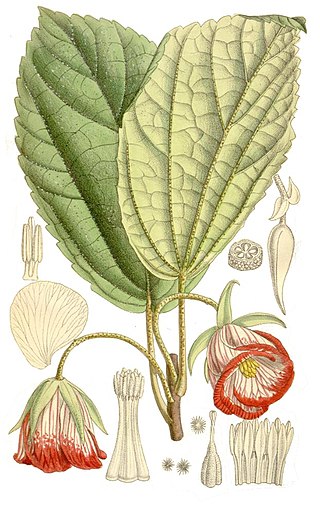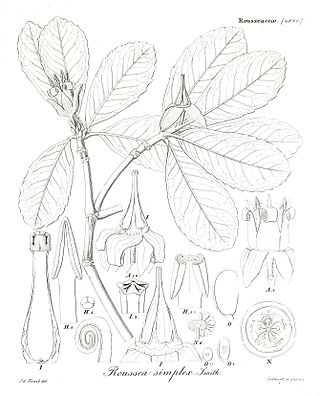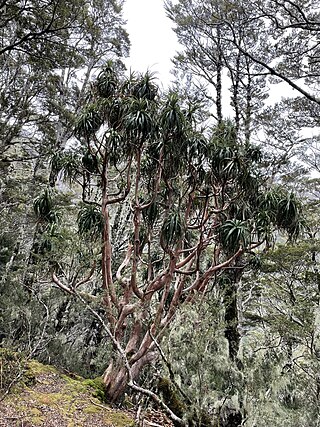
The Mascarene Islands or Mascarenes or Mascarenhas Archipelago is a group of islands in the Indian Ocean east of Madagascar consisting of the islands belonging to the Republic of Mauritius as well as the French department of La Réunion. Their name derives from the Portuguese navigator Pedro Mascarenhas, who first visited them in April 1512. The islands share a common geologic origin in the volcanism of the Réunion hotspot beneath the Mascarene Plateau and form a distinct ecoregion with a unique flora and fauna.

Strongylodon macrobotrys, commonly known as jade vine, emerald vine or turquoise jade vine, is a species of leguminous perennial liana endemic to the tropical forests of the Philippines. Its local name is tayabak. A member of the Fabaceae, it is closely related to beans such as kidney bean and runner bean. Strongylodon macrobotrys is pollinated by bats.

Brachychiton acerifolius is a large tree of the family Malvaceae endemic to tropical and subtropical regions on the east coast of Australia. It is famous for the bright red bell-shaped flowers that often cover the whole tree when it is leafless. It is commonly known as the flame tree, Illawarra flame tree, lacebark tree, or kurrajong.

Trochetia is a genus of flowering plants from the family Malvaceae. They are endemic to the Mascarene Islands.

Zombia antillarum, commonly known as the zombie palm, is a species of palm tree and the only member of the genus Zombia. It is endemic to the island of Hispaniola in the Greater Antilles. Usually found in dry, hilly areas of northern and southern Haiti and the northwest of the Dominican Republic, Z. antillarum is a relatively short fan palm with clustered stems and a very distinctive appearance caused by its persistent spiny leaf sheaths. Threatened by habitat destruction in Haiti, Z. antillarum is a popular ornamental species due to its distinctive appearance, low maintenance requirements and salt tolerance.

France Staub was a Mauritian ornithologist, herpetologist, botanist, and conservationist.
The wildlife of Mauritius consists of its flora and fauna. Mauritius is located in the Indian Ocean to the east of Madagascar. Due to its isolation, it has a relatively low diversity of wildlife; however, a high proportion of these are endemic species occurring nowhere else in the world. Many of these are now threatened with extinction because of human activities including habitat destruction and the introduction of non-native species. Some have already become extinct, most famously the dodo which disappeared in the 17th century.

Dictyosperma is a monotypic genus of flowering plant in the palm family found in the Mascarene Islands in the Indian Ocean. The sole species, Dictyosperma album, is widely cultivated in the tropics but has been farmed to near extinction in its native habitat. It is commonly called princess palm or hurricane palm, the latter owing to its ability to withstand strong winds by easily shedding leaves. It is closely related to, and resembles, palms in the genus Archontophoenix. The genus is named from two Greek words meaning "net" and "seed" and the epithet is Latin for "white", the common color of the crownshaft at the top of the trunk.

Dombeyoideae is a widely distributed subfamily of the Malvaceae, as proposed by the APG. Most of the plants placed here were once assembled with more or less related genera in the paraphyletic Sterculiaceae; a lesser number were placed in the Tiliaceae which were also not monophyletic.
Ruizia parviflora is a very rare shrub from the family Malvaceae. It is endemic to Mauritius.

Cuttsia viburnea is a shrub or bushy tree which has toothed leaves and panicles of white flowers, and that is endemic to eastern Australia. It is sometimes called silver-leaved cuttsia, and confusingly also native elderberry, honey bush or native hydrangea. C. viburnea is the only species assigned to the genus Cuttsia.
Achnophora is a genus of flowering plants in the family Asteraceae described as a genus in 1883.

Favratia zoysii, known commonly as Zois' bellflower, Zoysi's harebell, or crimped bellflower, is the sole member of the genus Favratia, closely related to Campanula (bellflowers).
Stockwellia is a monotypic genus in the flowering plant family Myrtaceae. The sole species in the genus, Stockwellia quadrifida, is endemic to Queensland.

Roussea simplex is a woody climber of 4–6 m high, that is endemic to the mountain forest of Mauritius. It is the only species of the genus Roussea, which is assigned to the family Rousseaceae. It has opposing, entire, obovate, green leaves, with modest teeth towards the tip and mostly pentamerous, drooping flowers with yellowish recurved tepals, and a purse-shaped orange corolla with strongly recurved narrowly triangular lobes.

Dracophyllum arboreum, commonly known as Chatham Island grass tree and tarahinau (Moriori), is a species of tree in the heath family Ericaceae. Endemic to the Chatham Islands of New Zealand, it reaches a height of 18 m (60 ft) and has leaves that differ between the juvenile and adult forms.

Veronica jovellanoides, commonly known as Riverhead speedwell, is a threatened flowering plant in the family Plantaginaceae. Endemic to New Zealand, only three plants are known in the wild. All are found within the Ernest Morgan Reserve, a 20 ha forest northwest of Auckland. Its discovery is accredited to a retired plant nursery owner, Geoff Davidson, who organised the land's protection a few decades prior, and found it by chance on a walk in November 2007.

Dracophyllum traversii, commonly known as mountain neinei, grass tree, and pineapple tree is a species of flowering plant in the heath family Ericaceae. It is a deciduous tree endemic to New Zealand. It reaches a height of 0.2–13 m (0.66–42.65 ft) and has leaves which form tufts at the end of its branches. It has a lifespan of between 500 and 600 years.

Ruizia is a genus of flowering plants belonging to the family Malvaceae. It contains 13 species native mostly to the Mascarene Islands, and one species native to Madagascar.

Dracophyllum fiordense, commonly known as the Fiordland grass tree, is a species of tree or shrub in the heath family, Ericaceae. It is endemic to the South Island of New Zealand. It reaches a height of 1.5–5.0 metres and has tufts of long green leaves at the ends of its branches. Each leaf has a distinctive curled spiral tip. D. fiordense has a pyramid-shaped inflorescence hidden under each clump of leaves, with between 113 and 120 pink flowers on each spike, and later reddish-brown dry fruit; both are around just 2 by 2 mm. It inhabits shrubland, lowland and subalpine forests, and tussock grassland of mountain slopes, gullies, and ridges. Its range covers two main areas: one in Fiordland National Park, and one in the Mount Cook and Westland National Parks.
















